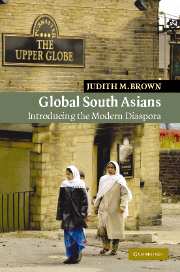1 - Traditions of stability and movement
Published online by Cambridge University Press: 05 June 2012
Summary
This chapter sets the scene for the rest of this study, by looking at the subcontinent of South Asia and its connections with the world outside, over time. Although individuals and family groups made the decision to move abroad, and we need to understand their small-scale and local decisions, these were taken in the context of a widening environment, that of the British Empire in the nineteenth and early twentieth centuries, and of a world of independent nations bound together by new patterns of globalisation in the later twentieth and the present centuries. Particularly crucial in this widening environment was the impact of demand for various forms of labour and skill, and the political issues related to immigration of people with different ethnic origins from the majority in areas where they sought to go.
The subcontinent under British rule: the image of rural stability
The great land mass of the Indian subcontinent, equivalent to Europe in size, came under the political control of Britain in piecemeal fashion from the middle of the eighteenth century to the early nineteenth century. In theory, the ruling authority was until 1858 the East India Company (EIC), a trading company whose origins lay in a royal charter of 1600. But as it transformed itself in the early 1800s into an organisation for governance and military control, its trading activities declined as a component of its activities and profit.
- Type
- Chapter
- Information
- Global South AsiansIntroducing the modern Diaspora, pp. 9 - 28Publisher: Cambridge University PressPrint publication year: 2006

